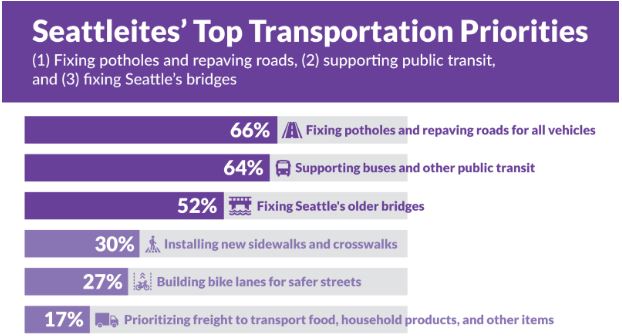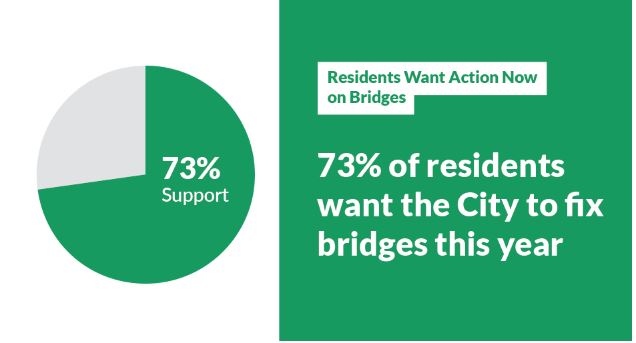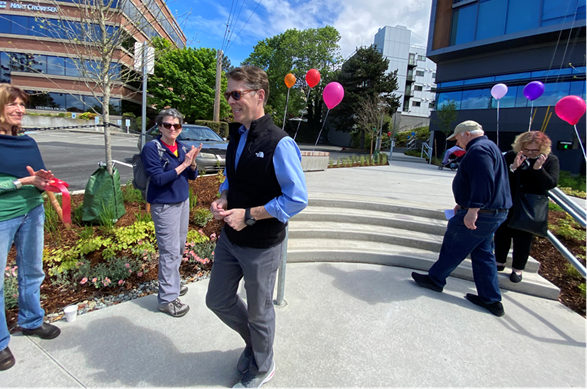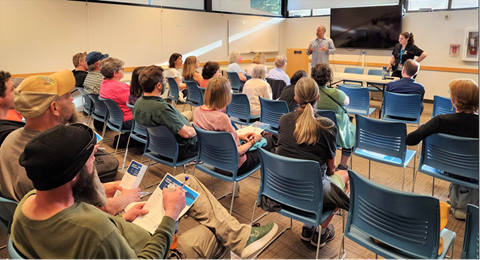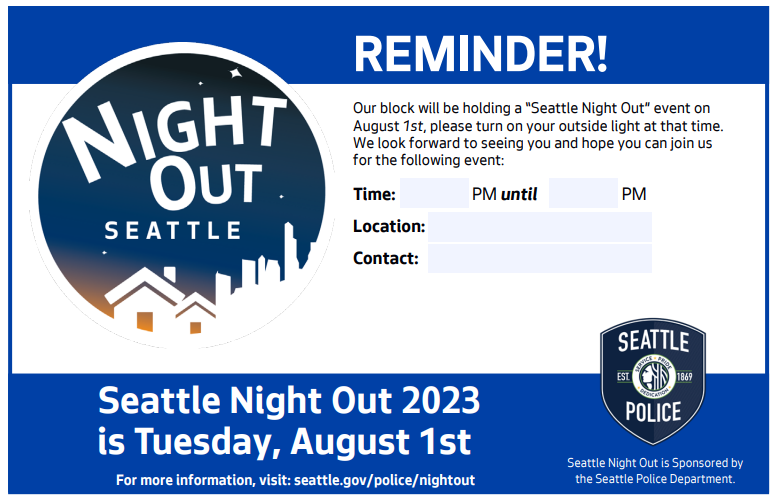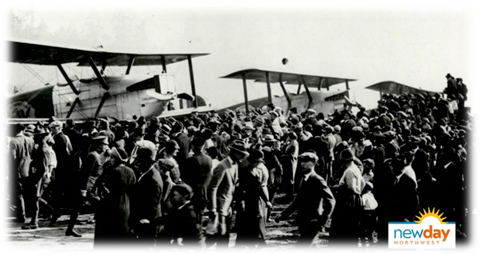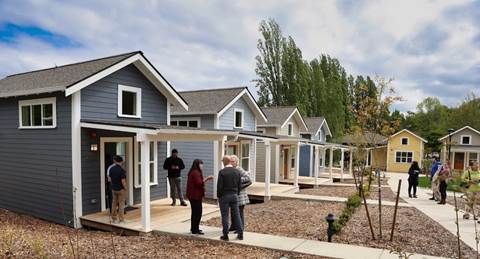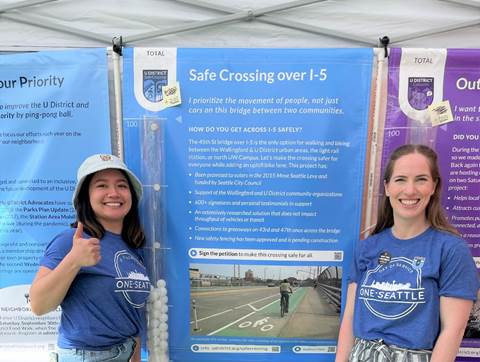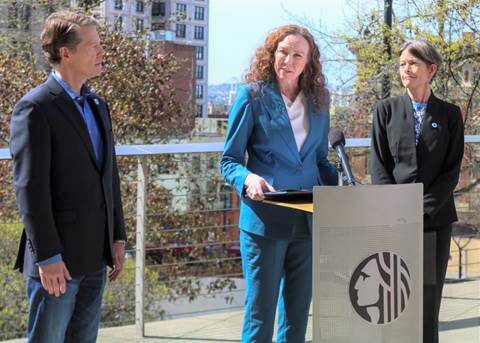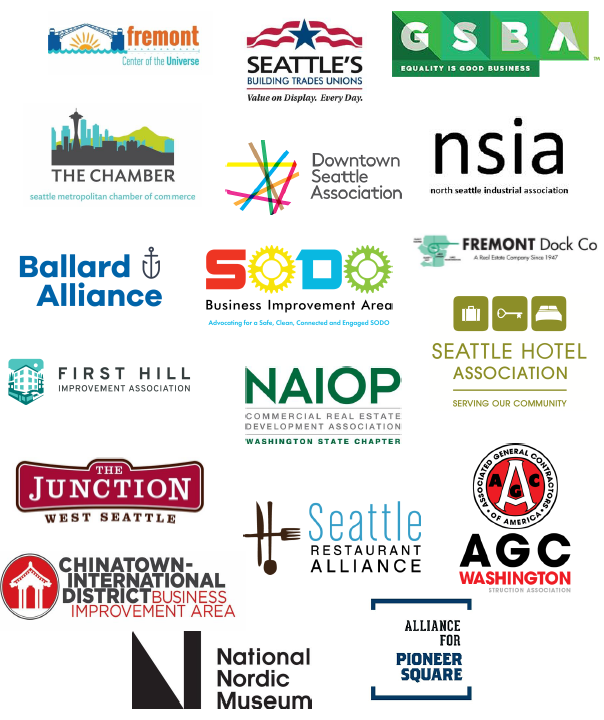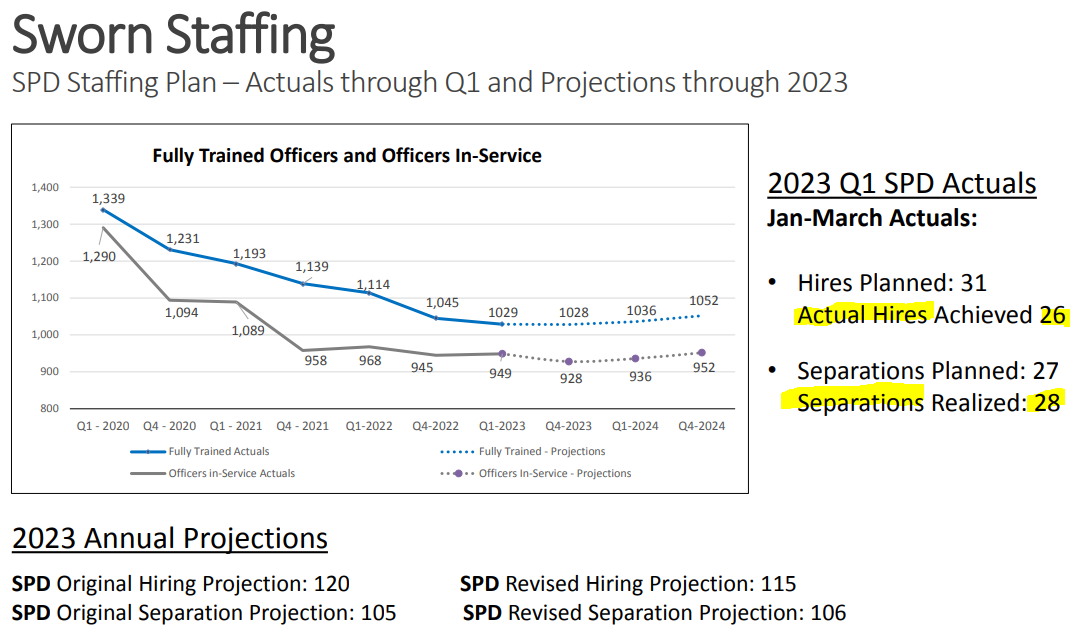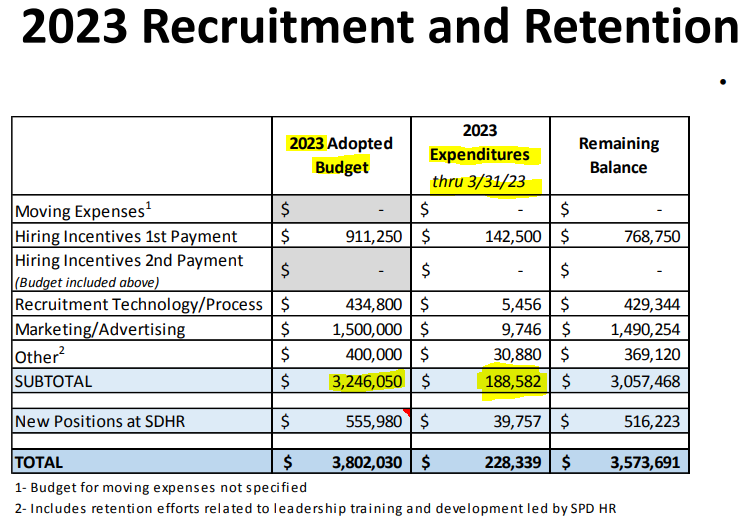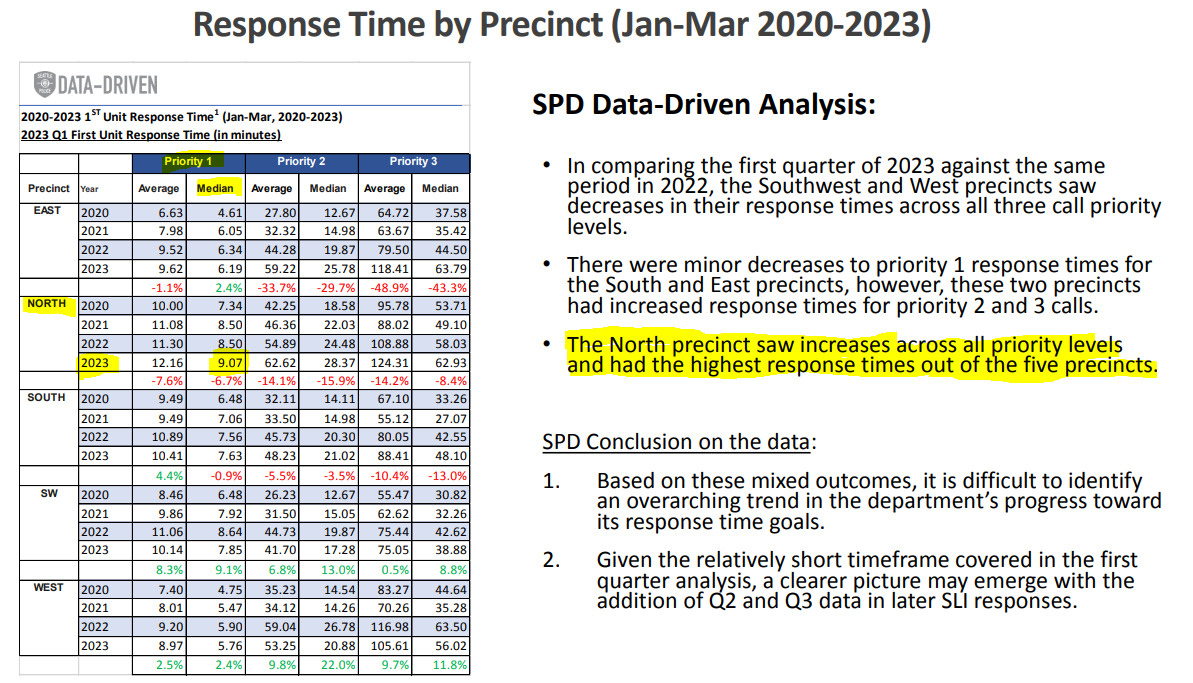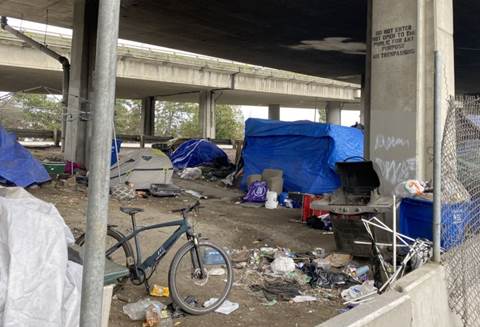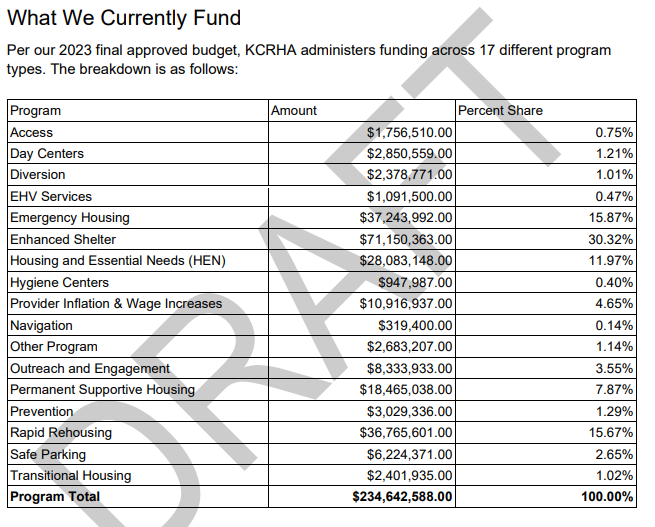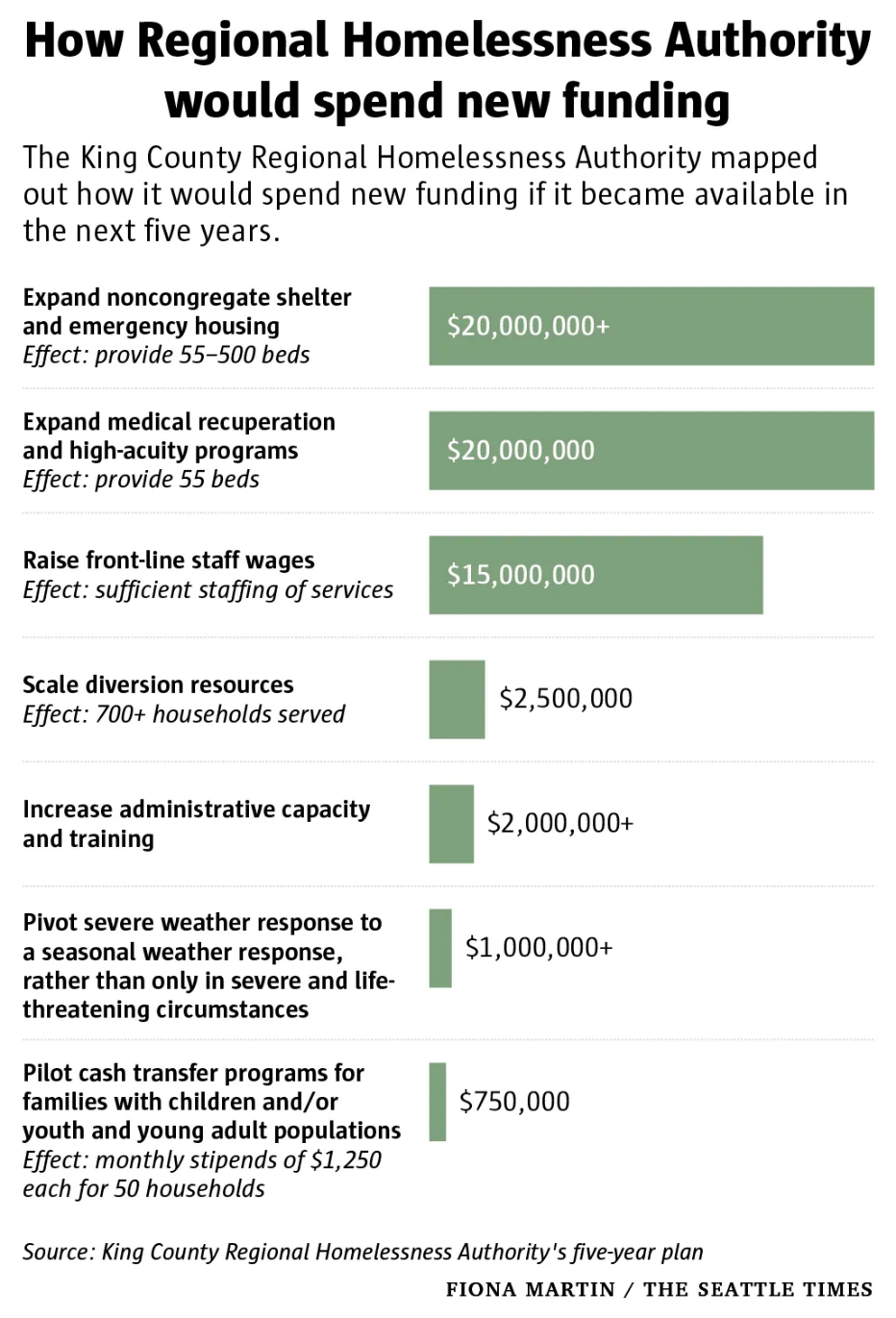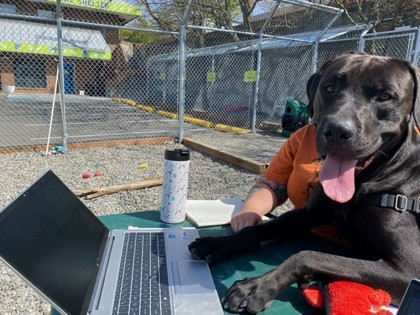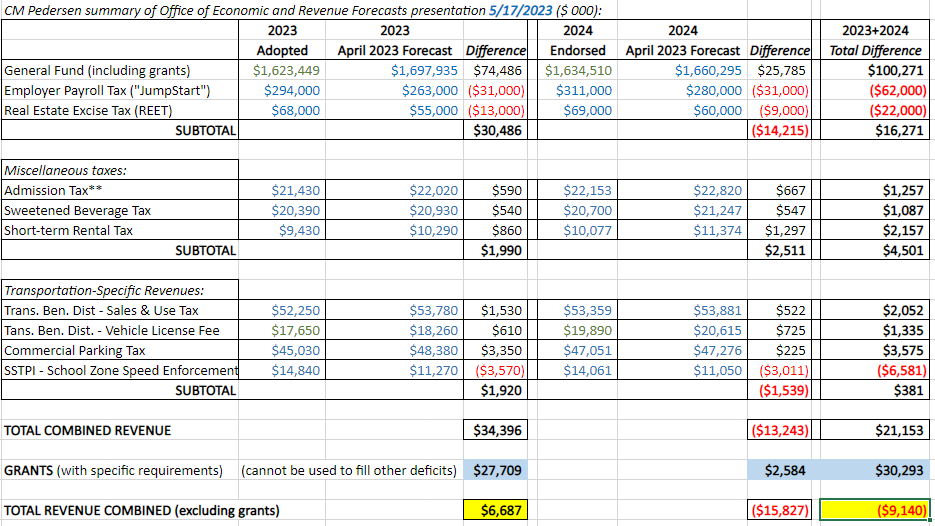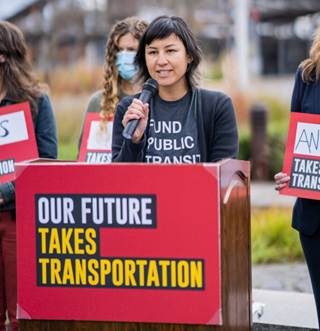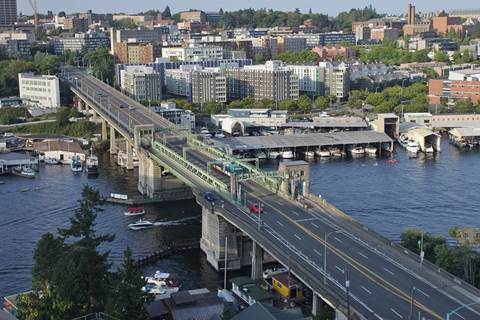May Survey Listens to Seattle
Friends and Neighbors,
In this month’s newsletter from City Hall and Northeast Seattle, we unveil new citywide survey results along with our regular riveting topics. Please click on the links below to zip to the sections that interest you the most:
- District 4: Eastlake Finishes Pedestrian Path; Hawthorne Hills / View Ridge Crime Prevention Meeting; D4 “National Night Out” Block Parties; Magnuson Park Aviation History and Low-Income Housing Future; U District Street Fair; Wallingford Farmers Market.
- Public Safety and Homelessness: Curbing Illegal Drugs in Seattle; Police Staffing Efforts Lagging; 9-1-1 Response Times Worsen; Low-Income Housing Funding Discussion Continues; Big Changes for Regional Homelessness Authority; Don’t “Deactivate” Pet Protections.
- Taxes and Budgets: City Revenues Sufficient for Now; Tax Reform Needed for Fairness; Let’s Stop Taxing Your Drinking Water.
- Land Use Policies Impacting Seattle: New Law Imperils Seattle Trees (in my opinion); Reasonable Updates to Maritime-Industrial Lands.
- Transportation & Seattle Public Utilities Committee: Seattle Wants Roads and Bridges Fixed; June is “Ride Transit Month”; New Leadership for Transportation Choices Coalition.
- Memorial Day: 270 words to remember.
- Providing Input.
For my previous newsletters, you can CLICK HERE to visit my website / blog. Thank you for caring enough to demand better from City Hall.
NEW SURVEY RESULTS FOR SEATTLE: YES, WE HEAR YOU!

We hear you, Seattle! This past month, we had a professional survey firm gather the views from a representative sample of Seattle residents on numerous issues (with a focus on transportation), and we’re sharing the results. This experiment in listening is important because, unlike the input policymakers receive from social media, bloggers, paid activists, or the loudest lobbyists, this survey is a statistically valid representation of the entire adult Seattle population. No survey is perfect, but we’re trying!
This new survey revealed the views of Seattle residents on pressing transportation and related topics, including 75% support for impact fees to pay for transportation infrastructure. Conducted May 5 through May 13, 2023, the survey asked several questions of 1,000 Seattle adults, including 500 live interviews by SurveyUSA, an independent professional firm used recently by the Seattle Times. With so many respondents, the margin of error is less than 4 points (plus or minus).
“I believe City Hall can hear Seattle residents more clearly and frequently with professional surveys that gather statistically valid input to cut through social media echo chambers and go beyond paid lobbyists and interest groups,” said Councilmember Alex Pedersen who asked for the survey. “Just as several other local governments poll their residents, Seattle City Hall can benefit from conducting its own statistically valid surveys, so we hear directly how the broader population is feeling about key issues, such as how best to pay for transportation priorities.”
In Seattle, surveys are typically conducted by political campaigns and not available to the public or policymakers. One recent exception is the Seattle Metropolitan Chamber of Commerce, which periodically conducts a statistically valid survey (“The Index”) and generously makes the results available to the public. The added benefit of City Hall also conducting its own surveys, however, is that your government officials will choose the questions and the frequency of asking them.
Here are some key findings from our May survey:
IMPACT FEE SUPPORT: For this survey, the question that earned the largest super-majority of 75% was about a new funding source for transportation infrastructure: impact fees.
The survey question: “Seattle may consider imposing fees on new real estate development projects to help pay for the city’s growing needs for transportation infrastructure. (For example, a real estate developer may have to pay $8,000 to the City government on a condominium project the developer hopes to sell for $800,000.) Would you support or oppose these transportation impact fees on new real estate developments to help pay for transportation infrastructure?
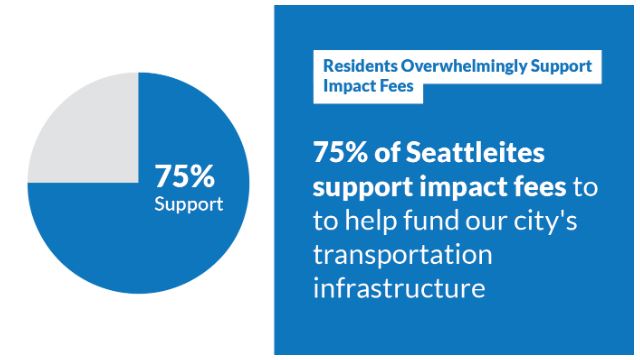
- Support: 75% (includes 42% strongly support)
- Oppose: 18%
- Not sure: 7%
Notably, no other public survey has asked this important question about impact fees, which are already collected in approximately 70 other Washington State cities. (Currently, a group of for-profit real estate developers is challenging City Hall’s efforts to pursue impact fees to pay for transportation infrastructure, which means City Hall would otherwise need to increase regressive sales taxes and/or property taxes.)
TRANSPORTATION PRIORITIES: The survey also found that the top 3 transportation priorities receiving majority support were: fixing roads, supporting transit, and fixing bridges. The survey question: Thinking now about transportation in Seattle. Of the following, which three transportation investments do you think are the most important for Seattle to make?
- Fixing potholes and repaving roads for all vehicles: 66% picked among their top 3.
- Supporting buses and other public transit: 64% picked among their top 3.
- Fixing Seattle’s older bridges: 52% picked among top 3.
- Installing new sidewalks and crosswalks: 30% picked among top 3.
- Building bike lanes for safer streets: 27% picked among top 3.
- Prioritizing freight to transport food, household products, and other items: 17% picked among top 3.
- Something else: 6%
- None of the above: 1%
[Note: As Chair of the City’s Transportation Committee, Councilmember Pedersen remains committed to Seattle’s Vision Zero goals to eliminate traffic fatalities and serious injuries.]
BRIDGES NOW: The question that garnered the second highest super-majority showed people want City Hall to take quicker action to fix bridges. The survey question: “After the West Seattle Bridge cracked and closed, the city ordered an audit of all Seattle bridges, which found several bridges in poor condition. Do you think the Mayor and the Seattle Department of Transportation should do more to fix Seattle’s worst bridges this year or should they wait until they have additional data on all bridges?”
- Fix Bridges This Year: 73%
- Wait for Data: 21%
- Not Sure: 6%
(Interesting “cross tab”: Even for people who did not pick bridges among their top 3 transportation priorities, 67% said fix bridges this year.)
More About This Survey:
In addition to several other timely questions on local government topics, the independent survey firm gathered standard demographic information on each of the 1,000 respondents, such as age, gender, race, income, etc. This enables the public and policymakers to cross reference the answers on the topical questions with the demographic information. For example, these “crosstabs” show that respondents who have lower incomes or reside in South Seattle were much more likely to choose filling potholes / repaving roads over other transportation priorities.
Links:
- Here’s the link to the full survey as provided by the independent survey firm, including all toplines results and crosstabs: https://www.surveyusa.com/client/PollReport.aspx?g=9f3e1ca3-5c62-4caf-be52-d360dae52e3e
- Here’s a more user-friendly PDF of the full survey that should be easier to print, including all topline results and crosstabs: https://pedersen.seattle.gov/wp-content/uploads/2023/05/Survey-results-2023.05.05-thru-2023.05.13-Seattle-adults.pdf
- For more information about the popular impact fees for transportation, CLICK HERE for the City Council’s website and CLICK HERE for my Councilmember blog. For the March 17, 2023 presentations to the Transportation Committee, CLICK HERE and HERE.
Since I’m not running for re-election, it’s not feasible to doorbell every day to hear directly from a cross-section of constituents and much of my role, even as a district Councilmember, is to consider policies impacting the entire city. So, for this survey, the respondents are adults (18 and older) from across the city. The concept of this survey and the actual questions to be asked were reviewed and approved in advance by the Executive Director of Seattle Ethics & Elections Commission (SEEC).
DISTRICT 4
Eastlake Ribbon-Cutting for Pedestrian Path
On Sunday, May 7, 2023, City Councilmember Alex Pedersen “got his steps in” at the ribbon cutting of the new East Howe Plaza Steps in the Eastlake neighborhood. The Councilmember joined a few vigorous souls (and dogs) who climbed the approximately 1,000 steps from Lake Union up to Capitol Hill’s 10TH Avenue to celebrate the new public-private partnership pedestrian porosity pathway project – pow! This community-led project fulfills the vision of connecting the pedestrian pathways from Capitol Hill along East Howe Street under I-5, down the hill through the Eastlake neighborhood to the Lake Union waterfront near 1910 Fairview Avenue East. This is a timely community connection, because redistricting is moving Eastlake from District 4 into District 3 for next year’s Councilmembers. This project was a long collaboration among the Eastlake Community Council, the private sector owners of the adjacent properties (which will provide ongoing maintenance), the Seattle Department of Neighborhoods (which provided initial design funding), and the Seattle Department of Transportation / Transportation Committee chaired by Councilmember Pedersen (which granted approvals via Council Bill 120281 adopted in April 2022 and Resolution 31988 adopted in March 2021). The new pathway is another fun reason to explore the Eastlake neighborhood. To get more involved in your neighborhood, contact your community council.
Hawthorne Hills / View Ridge Crime Prevention Tips
View Ridge Community Council President Robert Johnson and North Precinct Crime Prevention Coordinator Sarah Lawson lead a discussion on crime prevention tips in May.
The Hawthorne Hills Community Council and the View Ridge Community Council hosted an informative crime prevention tips meeting on May 3, 2023 at the Northeast branch of Seattle Public Library. Crime Prevention Coordinators are important civilian positions for our comprehensive approach to public safety and my office is proud to have secured funding for two of them back in 2021 because our North Precinct is the largest. To join your community council, CLICK HERE.
Community Safety + Fun with Neighbors = National Night Out August 1: Register Your Block Now
Look forward to the annual “National Night Out” on Tuesday, August 1, when neighbors once again block off their street to enjoy food and to build those neighborly relations that can help to spot and prevent criminal activity with improved communication and trust. Each year I attend several of these block parties in District 4 and I hope to again this year. To register your block or to see where nearby locations are, CLICK HERE.
Magnuson Park Aviation History: Upcoming 100th Anniversary of Flight Around the World
Did you know that Magnuson Park in our District 4 was a starting point for the first successful flight around the world nearly 100 years ago in 1924? Most people forget that the more famous flight of Charles Lindbergh across the Atlantic happened three years AFTER the little-known U.S. Army aviators circled the globe.
According to the Smithsonian’s Air & Space Museum, “On April 6, 1924, eight U.S. Army Air Service pilots and mechanics in four airplanes left Seattle, Washington, to carry out the first circumnavigation of the globe by air. They completed the journey 175 days later on September 28, after making 74 stops and covering about 27,550 miles. The airplanes were named for American cities and carried a flight number: Seattle (1), Chicago (2), Boston (3), and New Orleans (4)…Only the Chicago, flown by Lts. Lowell Smith and Leslie Arnold, and the New Orleans, flown by Lts. Erik Nelson and John Harding Jr., completed the entire journey.” For a city that’s also home to Boeing, CLICK HERE for more pioneering events in aviation history.
- To watch the interview of historian Felix Banel on King 5 News from May 10, 2023, CLICK HERE.
- For the Friends of Magnuson Park website, CLICK HERE.
- For an old video of the flight, CLICK HERE.
- For the 2021 aviation murals by kids project, CLICK HERE.
Magnuson Park: Home to More Low-Income Housing
Magnuson Park is already home to 850 low-income residents who reside in the housing provided by two nonprofits, Mercy Housing and Solid Ground. Now, the Low-Income Housing Institute (LIHI), led by Sharon Lee, has built 22 “cottages” just east of NE 65th Street in the park. For more information about Sand Point Cottages, CLICK HERE. As usual, State Representative Frank Chopp helped to make it happen. As many politicians talk and talk about shortages of housing, Rep Chopp gets it done project by project — and not with shallow promises of “affordable housing” with rents at 80% of area median income (AMI) or higher — which are actually the same as market rates – but with rents well below market that serve people experiencing homelessness (0 to 30% AMI).
U District Street Fair / One Seattle Day of Service
Gabby Lacson and Hannah Thoreson represented our District 4 Council office at the U District Street Fair during the “One Seattle Day of Service” on May 20, 2023. They enjoyed the fact that the NE 45th Street I-5 crossing project – which was funded (twice) by the City Council — earned among the most votes from the public in the non-scientific but fun survey. That provides yet another reason we look forward to SDOT / WSDOT hurrying to construct that pedestrian safety project that connects Wallingford to the U District!
Wallingford Farmers Market Returns for Summer
Councilmember Pedersen’s diet required him to use this photo from 2022, so that he didn’t have an excuse to eat 10 popsicles this year at the Wallingford Farmers Market, which is open this summer on Wednesday evenings.
Wallingford’s summer farmers market returned May 24 next to the Meridian Playground (N 50th Street and Merdian Ave N) and will be open every Wednesday 3:00 to 7:00 p.m. through September. In our District 4, you can also enjoy the University District Farmers Market every Saturday morning throughout the year.
- For the official website of the Wallingford Farmer’s Market, CLICK HERE.
- For the article about this year’s market in Wallyhood, CLICK HERE.
(For minor land use changes proposed by the Harrell Administration for the southern shoreline of Wallingford, see “Land Use” section below.)
SAFETY AND HOMELESSNESS
Finally Curbing Use of Illegal Drugs in Seattle
When our State legislature failed to agree on a law to address illegal drugs in Washington State, I stood with City Attorney Ann Davison and citywide Councilmember Sara Nelson on April 27, 2023 to introduce a local law to curb the use of those harmful drugs in Seattle. After the Governor called back the State Legislature for a special session to fill the gap for drug possession laws, we updated our legislation (Council Bill 120586) to reflect the statewide compromise. By reflecting the statewide compromise, this new version successfully prevents the “patchwork” or “piecemeal” approach that other Seattle officials raised as their concern when we introduced our original proposal to fill the gap.
Swift action by the Seattle City Council is needed because the State law goes into effect July 1, and it typically takes 30 days for our city ordinances to go into effect.
CALL TO ACTION: You can contact your City Council by emailing Council@seattle.gov and asking them to Please avoid a gap in illegal drug laws and prevent a piecemeal patchwork by adopting the statewide law here in Seattle (Council Bill 120586), as introduced by Councilmembers Nelson and Pedersen on behalf of our City Attorney.
State law (RCW 39.34.180) makes cities such as Seattle responsible for charging all misdemeanors and gross misdemeanors occurring in their jurisdiction. The Seattle City Attorney’s Office is responsible for prosecuting misdemeanors and gross misdemeanors in Seattle, but can charge cases only under the Seattle Municipal Code. In order to charge cases of drug possession or public drug use, therefore, the Seattle City Council needs to adopt the new state law into the Seattle Municipal Code.
- As King County Prosecutor Leesa Manion stated on April 28, 2023, “Even if our State Legislature successfully adopts a statewide fix, local ordinances will still be necessary to give appropriate jurisdiction to municipal prosecutors.”
- As Mayor Harrell’s Office communicated to KIRO 7 News on May 17, 2023, “…After each legislative session, the City Council amends the City’s criminal code to be consistent with changes the Legislature has made, and we support amending our local laws to comply with state law…With this law in place, the Legislature has provided an additional pathway that may help direct those in need to the treatment they deserve…”
- As confirmed on May 24, 2023 by the non-partisan Municipal Research & Services Center, “Cities must adopt or incorporate state statutes into their municipal code in order to prosecute misdemeanor or gross misdemeanor cases in city municipal court.”
Now that the State has acted, the ball is clearly in Seattle’s court, as a charter city, to take swift action to be consistent with the State.
Oregon recently experienced worse urban problems when trying to decriminalize drug possession. See the two April 13, 2023 articles from The Economist magazine by CLICKING HERE and HERE.
Implementing the law prohibiting use of harmful illegal drugs in public is not a complete solution to the public health and safety crisis facing Seattle, but it’s a necessary tool within a comprehensive approach that includes prevention and treatment.
The State legislation tacked on $19.6 million more in spending than a prior version, for about $62.9 million total. The additions include $9 million toward the Office of Public Defense to provide public defenders in certain areas for people charged with possession or use in a public place. It’s not clear how much of that funding would flow to King County or Seattle.
Here is our press release from May 16, 2023:
“[On May 16, 2023], City Attorney Davison with Councilmembers Nelson and Pedersen submitted updated legislation to prohibit drug possession and drug use in public places. The bill follows the Washington State Legislature’s passage of 2E2SSB 5536 in special session. The proposed legislation would bring Seattle into conformity with the State law. Conforming legislation is required in order for public drug use and drug possession to be charged by the Seattle City Attorney.
The proposed legislation can be found here: SCAO Controlled Substances Ordinance Proposal
“Seattle residents, local leaders and our elected officials have made it clear that enough is enough. The epidemic of drug use on our streets must be addressed. I’m gratified that the State has arrived at a bipartisan agreement and now it is time for Seattle to adopt those laws,” said City Attorney Ann Davison. “We need to use all the tools available to us at both a State and local level to move more people into treatment. Every day we delay, more lives are lost to substances.”
Councilmember Sara Nelson said, “The time for complacency on public drug use is over and we must use all the tools at our disposal to interrupt the cycle of addiction and help move people into recovery. Now that Olympia has appropriated resources for treatment and adopted a fix for Blake, we’re bringing our legislation into alignment to remove any further cause for inaction on the most critical public health and public safety issue of our time.”
Councilmember Alex Pedersen said, “Thankfully, State government leaders confirmed it’s not okay for people to smoke fentanyl or to use other illegal drugs in our public spaces or on our public transit, and the laws on the books need to reflect those basic public health and safety standards. Last month, we proactively introduced a stopgap safety measure for Seattle, and now we’ve updated it to match the State’s strong actions this week, so there’s no longer any excuse for City Hall inaction. The time for excuses is over and the time for action is now.”
On April 27, Davison, Nelson, and Pedersen introduced a Seattle bill to prohibit public use of illegal drugs to fill the gap in the law when the State Legislature initially adjourned without a statewide fix. Their Seattle proposal was similar to proposals from other fast-acting jurisdictions across the state, which were also eager to take appropriate and responsible action to fill the legal gap. Governor Inslee called State legislators back for a special session to craft a state-level measure, which they adopted today, May 16.
On May 11, several neighborhood and citywide business and civic groups sent a letter to the Seattle City Council stating, “We urge the City Council to address this public health emergency head on and with the urgency it demands.”
MORE INFO:
- For our May 16, 2023 press release, CLICK HERE. For our April 27, 2023 press release, CLICK HERE.
- For Seattle Times coverage of the State legislature’s adoption of their Gross Misdemeanor compromise on May 16, 2023, CLICK HERE. For video coverage from KIRO 7 News that includes Governor Inslee’s statement and highlights a recovery program, CLICK HERE.
- For a KIRO 7 News interview with CM Pedersen May 17, 2023, CLICK HERE.
- For the Seattle Times coverage of the City Attorney’s revised ordinance on May 19, 2023, CLICK HERE.
- For a KING 5 News interview of our City Attorney Ann Davison May 25, 2023, CLICK HERE.
- For a letter of support from the business community 5/11/2023, CLICK HERE.
- For the 3-page piece of legislation for Seattle (Council Bill 120586), which simply adopts the State version, CLICK HERE.
- For the May 24, 2023 analysis by the nonpartisan Municipal Research Services Center (MRSC), CLICK HERE.
- For the Seattle Times editorial from May 30, 2023 which states, “The Seattle City Council should pass a proposed ordinance prohibiting drug possession and use in public places.” CLICK HERE.
- For the Seattle Times April 16, 2023 article, “How fentanyl became Seattle’s most urgent public health crisis,” CLICK HERE.
- For Seattle Times columnist Danny Westneat’s recent analysis of Bellingham’s tougher actions, CLICK HERE (April 12, 2023) and for his December 3, 2022 column “Between prison and pamphlets: WA looks for an answer to the drug crisis,” CLICK HERE.
- For Mayor Harrell’s Executive Order on fentanyl and initial pieces of his “downtown activation plan” from April 17, 2023, CLICK HERE.
- For the compelling editorial cartoon by David Horsey that visualizes the harm of doing nothing for people under the grip of illegal drug addiction (April 14, 2023), CLICK HERE.
Police Hiring Efforts Falling Behind?
The Mayor’s Office efforts to have SPD increase recruitment and retention there are falling behind with a net loss of 2 officers when we’re trying to increase the net number of officers by 400 to make up for the ones lost during the unproductive defund rhetoric of 2020-2021. Why is the new recruitment and retention effort falling behind? A key indicator of this back-sliding is that it’s taking too long to get the money out the door.
By the end of the first 25% of this year, the executive branch had spent only 6% of the funds provided by the City Council. What are the reasons for the sluggish investments? Our City Council Central Staff reports, “The Mayor’s staff has indicated that the delay in spending is due to the implementation of an updated marketing plan that takes advantage of new staff, existing capabilities, and initial advertising analytics to attract new recruits effectively and cost-efficiently. This updated marketing plan allows the City to test, iterate, and improve initial messaging and tactics over the first half of the year, and then be more confident that increased spending in the second half of the year will drive results. The SPD staffing crisis is a significant and urgent challenge, but the City is following best-practices to be a responsible steward of public dollars and make evidence-based marketing decisions. While this approach will take longer to ramp up, the Mayor’s Office believes it will ultimately lead to better results per marketing dollar compared to an initially proposed plan.”
In politics, experienced practitioners listen intently and then quickly test, deploy, and revise their messaging within a matter of days or weeks rather than months. This same urgency should be applied to our police staffing crisis. The lack of results thus far to recruit and retain in a way that produces a net gain instead of a net loss is directly impacting our constituents in a negative way with unacceptably longer response times in North Seattle, as shown in the table below.
I previously reported on the expected net reduction of police officers in my March 31, 2023 newsletter (CLICK HERE), and the May 23, 2023 presentation from City Council’s Central Staff analysts confirms it (CLICK HERE).
9-1-1 Response Times Too High
As the table of 9-1-1 response times proves, our North Precinct has a troubling 9-minute median response time from police to the biggest public safety emergencies. For example, if a burglar is breaking into your home while your family is there, the median response time is 9 minutes. These lengthy response times for our North Precinct:
- Far exceed the best practice standard for safe response,
- Remain the highest in the City, and
- Have worsened since 2022 and 2020.
The already high response times getting worse in the North Precinct is unacceptable, and I have asked the Mayor’s Office and SPD leadership to explain why this is happening and what they are doing to remedy the situation. I believe we need a second police precinct from which to deploy patrol cars in the North Precinct because it is, by far, the largest geographic area in Seattle, among the five precincts with 40% of its population.
For the May 23, 2023 presentation from City Council’s Central Staff analysts, CLICK HERE. For a pre-pandemic article on SPD response times implying that the longer response times in the North Precinct have a long history, CLICK HERE.
Low-Income Housing Levy Proposal: Discussion Continues
The latest City Council committee meeting to discuss Mayor Harrell’s proposal to expand Seattle’s programs to create low-income housing was scheduled for May 31, 2023 at 9:30 a.m., with a public hearing at 4:30 p.m. For a link to that committee agenda, CLICK HERE. For the recent 24-page analysis by our City Council Central Staff, CLICK HERE. For my previous coverage on this topic, CLICK HERE. If you’re reading our newsletter after that May 31 meeting, no worries — final committee action is scheduled for June 7 and 21. For the latest schedule, CLICK HERE.
CEO of King County Regional Homelessness Authority Leaving June 30, 2023
This dangerous, long-term encampment under I-5 near a public elementary school (at NE 42nd Street (between 5th Ave NE and Pasadena Place NE) became a symbol of KCHRA’s shortcomings in reducing harmful, visible homelessness — and even riled the Governor.
This month, Marc Dones, the head of the King County Regional Homelessness Authority (KCRHA), announced their resignation. I’m hopeful we can attract a strong administrative leader who can navigate and improve our region’s provider-driven political arena to deliver results that bring more people inside faster. It’s important for me to note my continued support for KCRHA, not only because we still need a regional solution to this regional problem, but also because previous organizational structures failed to take quick action and deliver results. Like a start-up organization ready for its next level of leadership, KCRHA is ready with staff, funding, and lessons learned — poised to reduce visible homelessness. To do this, I believe it should focus on getting people inside faster, rather than trying to placate every stakeholder or getting distracted by expensive and grandiose goals. Few things counter the complaints and critics faster than visible success.
- For KCRHA’s May 16, 2023 statement on the resignation, CLICK HERE.
- For the official joint reaction from Seattle Mayor Harrell and King County Executive Constantine, CLICK HERE.
- For a critique of KCRHA by Seattle Times columnist Danny Westneat on May 20, 2023, CLICK HERE.
- For a more upbeat Op Ed about KCRHA written by three leaders from business, nonprofit, and philanthropy, CLICK HERE.
- For the Seattle Times May 26, 2023 editorial entitled, “Double down on homelessness authority’s founding principles and update CEO’s job description,” CLICK HERE.
KCRHA Leaders to Vote Revisions to 5-Year Plan to Reduce Homelessness:
Note: KCRHA’s budget does not include the locally funded Seattle Housing Levy that creates additional low-income housing units each year and the federally funded Seattle Housing Authority that operates public housing (such as Yesler Terrace) and provides Section 8 vouchers.
On June 1, 2023, the Governing Committee of the King County Regional Homelessness Authority will vote on its 5-Year Plan to Reduce Homelessness, after that plan was heavily revised by KCRHA staff and recommended by the “Implementation Board.” These latest revisions better prioritize existing funds, provide more specifics on short-term goals, and focus actions on a unifying, overarching goal: “to Bring Unsheltered People Inside as Quickly as Possible to Prevent Death and Further Harm.”
For one of the best summaries of what in the heck is going on with KCRHA’s revised 5-year plan, CLICK HERE for the May 18, 2023 Seattle Times article by Greg Kim. That article states, “The King County Regional Homelessness Authority has scaled back the ambitions of its five-year plan after officials and residents balked at the $10 billion to $12 billion figure proposed in January. If adopted, this would be a foundational document guiding the authority’s work going forward, and this new iteration replaces an emphasis on the huge amount of need with a list of actions the authority can take now to make the homelessness system more efficient… Now, items are prioritized based on what would get funded first with any new revenue. The biggest-ticket items include adding shelter with individual rooms, shelter for people with severe medical, mental and substance use disorder needs, and raising wages for front-line workers.”
Mayor Harrell as well as City Councilmembers Lisa Herbold and Andrew Lewis play a key role as members of the Governing Committee. Because Seattle is contributing the bulk of the funds and suffering the bulk of unsheltered homelessness, we should not be shy about requesting improvements to the sluggish pace of results and any inadequacies of future plans. I support this regional approach and want it to succeed. Success will continue to require active engagement from that Governing Committee. For example, oversight will be improved by adoption of Andrew Lewis’ Resolution (2023-04) requiring KCRHA staff to produce a more practical and short-term “Operational Plan” and to report on those operations frequently.
Seattle has seen several plans to reduce homelessness come and go. The fact is we don’t need to wait for yet another plan to reduce homelessness. City Hall can get the data we need to optimize use of the 16,000 units subsidized by the City’s Office of Housing portfolio to accept more housing-ready individuals from tiny home villages and enhanced shelters who have been waiting for a permanent unit. That effort would then enable City and regional homelessness officials to move more people who have been suffering unsheltered in parks, greenways, and sidewalks into safe tiny home villages and enhanced shelters.
More Info:
- 5-Year Plan Versions: For the initial 133-page draft 5-year plan from KCRHA staff posted on January 18, 2023, CLICK HERE. For the 22-slide PowerPoint summarizing the many important revisions from KCRHA staff on April 20, 2023, CLICK HERE. For the not-very-helpful 12-slide PowerPoint summarizing the revised 5-year plan, CLICK HERE. For the 100-page revised draft 5-year plan (which includes 40 pages of appendices) as recommended by KCRHA’s Implementation Board and presented June 1, 2023 for a vote to the Governing Committee, CLICK HERE.
- For the June 1, 2023 agenda of the Governing Committee (which was very hard to find online!) CLICK HERE. For links to the meeting materials (such as the Operation Plan Resolution), CLICK HERE. Note: It’s hard to find the actual revised 5-year plan, so here is the link again to that 100-page document (CLICK HERE).
- For my initial (January 2023) critique of KCRHA staff’s initial 5-year plan (too slow and too expensive), CLICK HERE.
- For the concerns from the Seattle Times editorial board published on February 21, 2023 (focused on the unrealistic cost of KCRHA’s plan), CLICK HERE.
- For the excellent Op-Ed by Sharon Lee and Pastor Robert Jeffrey, Sr. published March 10, 2023 in the Seattle Times, CLICK HERE.
- For an excellent summary of the revisions to the KCRHA 5-year plan, CLICK HERE for the May 18, 2023 Seattle Times article by Greg Kim.
IF OUR PETS COULD WRITE LEGISLATION: Don’t Let Council Bill 120580 “Deactivate” Protections for our Pets
If our pets could write new laws, they would probably make sure they’re protected. Currently there is a well-intentioned proposal to limit when app-based companies can “deactivate” the independent contractors who use their technology to engage with customers. The legislative proposal is just in draft form right now, but here’s one of the things that should be added: pets. The law aims to balance the rights of the companies with fairness toward the independent workers, so those workers are not unfairly deactivated from using the application for the services they provide. This includes companies based in Seattle, such as Rover, that provide not only jobs and tax revenue for our city, but also connect pet sitters/walkers with pet owners. Currently the legislation does not define misconduct against pets as a reason for deactivating. Protections for pets should be added.
CALL TO ACTION: If you have concerns, you can email City Council at Council@seattle.gov to tell them, “Protect pets, too, with the app-based labor standards of Council Bill 120580! Don’t let the legislation inadvertently ‘de-activate’ protections for our pets!” Feel free to include a picture of your pet as well!
MORE INFO:
- To review the draft legislation of Council Bill 120580, CLICK HERE.
- For the memo from our City Council Central Staff that identifies issues with the proposal, CLICK HERE and, for their May 23, 2023 presentation, CLICK HERE. For the current draft definitions of “Egregious Misconduct,” go to slides 7-10. Note: This analysis does not yet include pets.
- If you don’t have a pet yet, consider “Kafka” (the doggie in the photo above) as well other dogs, cats, rabbits, and other cute creatures from our Seattle Animal Shelter.
TAXES AND BUDGETS
April Revenue Forecast Updated/Confirmed: City Hall Can Still Pay the Bills, For Now
April Revenue Forecast Updated/Confirmed: City Hall Can Still Pay the Bills, For Now
In my April 26, 2023 newsletter, I analyzed the latest forecast of City revenues, which showed a relatively small surplus of $6 million this year (2023) when combining our large, flexible General Fund with other funds such as the new JumpStart Payroll Tax Fund (and after subtracting restrictive federal grants). That small surplus becomes a small deficit of approximately $6 million by the end of 2024. This April 2023 information was updated with only minor changes during a May 17, 2023 meeting of our City Council’s Finance Committee, showing the 2024 deficit as slightly higher at $9 million, which is still a drop in the bucket out of the annual $2 billion overall non-capital, non-utility revenues. If, however, labor negotiations result in additional pay increases for all City government employees (who currently average $100,000 annually, not including health benefits and pensions), the budget deficits are expected to grow in 2025 and beyond. Future deficits could be mitigated somewhat by miscellaneous reserves and, presumably, City Hall could tap the approximately $20 million still unspent for vague “participatory budgeting.”
More Info:
- For the uneventful May 17, 2023 update from Seattle’s Office of Economic and Revenue Forecasting, CLICK HERE.
- For the 16-page memo, dated May 17, 2023, from City Council’s Central Staff analyzing the updated figures and closing out the 2022 budget year, CLICK HERE, and for their 12-slide PowerPoint, CLICK HERE.
Unfortunately, both presentations continue to separate the General Fund from the other funding sources, so we rarely see a single table that answers the comprehensive, yet basic question, “Will our City government have a deficit or a surplus?” As a policymaker, I have to ask for the combined information separately and/or do it myself (combining slides 12 and 14 from the May 17, 2023 presentation from the Office of Economic and Revenue Forecasting as shown above).
NEW REVENUE NEEDED? If we have a surplus this year, why did the Mayor and Budget Chair establish a “Revenue Stabilization Workgroup” in October 2022? Good question! As city government personnel costs continue to increase at an unsustainable level, we expect larger deficits to return in 2025. But rather than going back to the well of the general taxpayer of Seattle, why not just better manage our costs?
As I noted last month, the Washington State Supreme Court recently allowed the State’s new capital gains excise tax to remain. The State’s new capital gains excise tax exempts retirement accounts and real estate sales and applies only to capital gains of more than $250,000. (For Frequently Asked Questions about that new excise tax, CLICK HERE.) Perhaps Seattle will consider a similar local measure here, although that could put Seattle at a disadvantage relative to other cities. Regardless, I believe City Hall should apply any new progressive revenue to reducing regressive taxes that we already pay, rather than spending it on additional costs of government. For example, if we introduce a new progressive tax in Seattle, I believe we should use it first to reduce the regressive utility taxes (see below) and the regressive sales tax paid today by everyone, and we should use it to reduce property tax increases paid by Seattle homeowners and renters.
Tax Reform Needed For Fairness: Let’s Stop Taxing Your Drinking Water!
Did you know that City Hall taxes your drinking water? It’s called a “Utility Tax” and it’s authorized under State law. But that doesn’t make it right. For greater fairness, we need tax reform in Seattle, starting with our drinking water.
For years, Seattle politicians have been decrying regressive taxes and yet we continue to charge regressive utility taxes, including on our drinking water. Why? Because our City’s General Fund uses those utility taxes to fund city government operations. Of the approximately $186 million City Hall takes from Seattle Public Utilities (SPU) and Seattle City Light, approximately $37 million comes from your drinking water bill – an arbitrary tax above and beyond the actual drinking water charges from SPU.
For drinking water, residential customers pay a 15.5% tax. While the annual water tax cost for the typical Seattle household is difficult to calculate, figures from previous reports and recent increases indicate it exceeds $100 per year. And that extra water tax is regressive, which means lower-income households pay a greater portion of their household income for this tax. The “Utility Discount Program” is insufficient not only because most eligible families don’t use it, but also because it covers only part of the bill with the remaining portion still a regressive charge by City Hall.
As noted earlier, our Washington State Supreme Court recently allowed the State’s new capital gains excise tax to remain. Thankfully, its first round of collections generated much more than expected, as reported recently by the Seattle Times. The State’s new capital gains excise tax exempts retirement accounts and real estate sales and applies a 7% charge only to capital gains of more than $250,000. (For Frequently Asked Questions about that new excise tax, CLICK HERE.)
An additional 1% to 2% charge of that new capital gains excise tax here in Seattle could remove the water tax paid by all Seattle residents. Instead of just talking about tax reform, let’s do it. We can start by ending the regressive water tax here in Seattle.
LAND USE POLICIES IMPACTING SEATTLE
City Council Adopts Ordinance Putting More Seattle Trees at Risk; Pedersen Lone No Vote
illustration by Frits Ahlefeldt
May 23, 2023 was sad day for Seattle’s trees: in a vote of 6 to 1, the City Council approved a harmful tree ordinance despite “…the flawed and rushed process, the likelihood of canopy inequities persisting or worsening, and the limited reporting requirements…”, as criticized by the Urban Forestry Commission (UFC). The UFC urged Councilmembers to postpone the decision, so that amendments could be discussed with the full City Council during June and July. To honor that request from the UFC, I made a motion to postpone to July 25. When it was clear that the motion to postpone would not pass, I amended my motion to June 27 (just 30 days), arguing that we could amend the implementation start date from the current 60 days to 30 days, thereby losing ZERO TIME. A majority of my colleagues still voted NO on that reasonable compromise motion, although Councilmember Herbold supported it with me. Then the Council approved the fateful, final bill to update the tree “protection” regulations (Council Bill 120534).
- Voting in Favor of CB 120534: Herbold, Lewis, Morales, Mosqueda, Nelson, and the sponsor Strauss.
- Voting Against: Pedersen.
- Absent: Juarez, Sawant.
With that 6 to 1 approval, the bill went to Mayor Bruce Harrell to sign into law. As he transmitted the original bill with Land Use Chair Strauss, his signature was expected.
The Seattle Times editorial board summed it up: “Think about the recent heat wave. If this bill passes, next year there will be less shade and higher street-level temperatures…It comes down to this: Trees don’t give campaign contributions. But the people who want to cut them down do…”
Get ready to hear an increase in chain saws just in time for summer heat waves when everyone needs that shade the most.
Despite the outcome, I greatly appreciate the hard work by our City Council Central Staff as well as by all legislative aides who worked quickly to analyze the complex bill and tsunami of 61 amendments.
Here are my remarks at the May 23, 2023 City Council meeting:
MOTION TO POSTPONE. At the request of the Urban Forestry Commission, I move to postpone this item, Council Bill 120534, until our full City Council meeting on July 25, 2023, which is the last Tuesday in July, approximately 60 days from today.
I have faith in the City’s Urban Forestry Commission with their expertise and their care. The letter from the Urban Forestry Commission, dated May 17, 2023, stated, “Given the flawed and rushed process, the likelihood of canopy inequities persisting or worsening, and the limited reporting requirements, the UFC asks the Council to: Defer voting on the bill until the end of July to allow Councilmember conversations with the UFC and other stakeholders...”
Providing more time is important not only to honor the request of a respected City commission, but also to honor our own Seattle Municipal Code. As stated in the Urban Forestry Commission’s May 17 letter, “The Mayor’s draft ordinance was transmitted to the City Council on March 7, 2023, and referred to the Land Use Committee on March 22, 2023. These actions occurred without prior review and recommendations by the UFC. This appears to be in violation of SMC 3.72.050.A.3, which states that it is the responsibility of the UFC to ‘provide recommendations on legislation concerning urban forestry management, sustainability and protection of associated trees…PRIOR TO its introduction and referral to any Council committee.‘”
RATIONALE FOR VOTING NO ON THE BILL (after motion to postpone failed): Colleagues, I believe it’s vital that we clarify that, while this bill might “regulate” and “define” and “designate” more trees, it does NOT absolutely protect them. This bill still allows these trees to be ripped out and destroyed, so I believe that’s the opposite of “protection.” I’ve issued several statements about the many public health and environmental benefits of conserving mature, healthy trees throughout Seattle — trees are vital environmental infrastructure in the face of the heat domes of climate change — and I’ve made several attempts to support the most substantive amendments requested by our Urban Forestry Commission.
Rather than restating those positions here today, I’ll simply read a key excerpt from the Seattle Times editorial board from this past weekend, which stated: “The Seattle City Council is on the verge of a very big mistake that would make Stumptown a more accurate moniker for Seattle than the Emerald City. On Tuesday [today], the full council is set to consider a new tree protection ordinance that recently passed the Land Use Committee. [The] Trouble is, …[the] process produced a pro-developer tree removal measure instead of one that actually preserves and grows trees. The council should vote it down and start over. As written, CB 120534 will almost certainly result in diminished tree canopy, flying in the face of the city’s stated environmental goals…” “If this bill passes, next year there will be less shade and higher street-level temperatures.”
Here are my remarks after the Land Use Committee rejected several of the amendments I carried to support the Urban Forestry Commission on May 4, 2023:
“I’m disappointed that the net impact of this so-called tree ‘protection’ legislation will be a death sentence for hundreds of trees throughout our city, even after City Hall has proof our Emerald City recently lost hundreds of acres of trees and our residents continue to suffer the harsh heat of climate change. The rhetoric that this new law “protects” more trees does not hold water, because the law simply redefines and regulates trees differently, rather than actually installing the stronger protections needed to advance the important public health and environmental benefits of a healthy urban forest. Unfortunately, we’ve waited all these years to witness City Hall produce more of a ‘profits protection bill’ than a tree protections bill. If City Hall leaders had heeded the expertise of the Urban Forestry Commission, we could have made real progress after all these years, instead of cutting down the vision of a healthy, growing urban tree canopy for all to enjoy. “
More Info:
- For the Seattle Channel video of the May 23, 2023 Council meeting with lots of passionate public comment, CLICK HERE.
- For the May 17, 2023 letter from the Urban Forestry Commission urging a delay to allow for additional amendments needed to protect trees, CLICK HERE.
- For the May 19, 2023 editorial by the Seattle Times, entitled, “Seattle’s proposed tree ordinance is the legislative equivalent of a chain saw,” CLICK HERE.
- For a May 19, 2023 article by KNKX public radio, CLICK HERE.
- Alternative viewpoint:
- For the May 23, 2023 press release from Mayor Harrell and Councilmember Strauss in support of their bill, CLICK HERE. (Editorial Comment: As I stated in my remarks, while this bill might “regulate” and “define” and “designate” more trees, it does NOT fully “protect” them. Calling them “protections” is misleading. Their legislation still allows most of these trees to be ripped out and destroyed, so I believe that’s the opposite of “protection.”)
- For bloggers who vocally opposed my amendments to protect trees that I sponsored to honor the expertise of the Urban Forestry Commission, CLICK HERE and HERE. Unfortunately, those bloggers seem to conflate carrying the recommendations of the UFC with opposing additional housing development, which is untrue and flies in the face of my record of financing thousands of low-income housing units over the past decade and serving on the advisory group that sparked the doubling of the Seattle Housing Levy in 2016.
- For the legislative agenda of the May 4, 2023 Land Use Committee with links to the amendments to Council Bill 120534 and other materials, CLICK HERE.
- For the summary list of Land Use Committee amendments and how each Councilmember voted, CLICK HERE.
- NEW: For a “tracked changes” version of Council Bill 120534 (which indicates how the amendments approved by a majority of the Land Use Committee were incorporated), CLICK HERE. (And, for the 8 supplemental requests of the executive branch regarding this tree “protection” ordinance, CLICK HERE).
- Regarding the two-part video of the May 4, 2023 Land Use Committee discussion and votes, for session 1, CLICK HERE and for session 2, CLICK HERE.
- For the May 3, 2023 letter from the Urban Forestry Commission (UFC) with their updated recommendations on the pending amendments, CLICK HERE. For the Urban Forestry letter, dated April 7, 2023, CLICK HERE.
- For the April 25, 2023 Seattle Times editorial urging passage of my UFC-related amendments, CLICK HERE.
- For a KUOW news article May 5, 2023 analyzing the committee action entitled “As Seattle loses tree canopy, a city council bill may let developers cut down more,” CLICK HERE.
- For Councilmember Pedersen’s blog, go to: https://pedersen.seattle.gov/strengthening-seattles-tree-ordinance/
Maritime-Industrial Lands: Reasonable Updates Proposed by Harrell Administration
Big picture, I strongly support protecting the zoning that maintains our maritime industrial economy because that zoning fosters good, long-term jobs to Seattle residents without college degrees and sustains existing Seattle-based businesses and our regional Port. Thanks to a thorough stakeholder process led by experienced professionals, it appears the Harrell Administration has crafted a reasonable balance in opening alternative uses for just some of that land not actively used today by maritime industrial jobs or freight routes, while strengthening protections of key remaining maritime industrial geographies.
As usual, the devil is in the details, and I’d expect strong opposition to any amendments that would upset the delicately crafted balance, such as any new sweetheart deals for landowners jockeying to increase their land values or profit potential. Real estate developers have already racked up big wins in Seattle recently: our State’s elected officials aggressively pre-empted our city to trump density decisions in “neighborhood residential” zones and the Harrell Administration got a majority of my colleagues to adopt relatively weak tree legislation that guarantees developers 85% hardscape on all low-rise lots and 100% hardscape on higher density areas, leaving little to no room for large trees in those areas in the midst of climate change heat waves. With a new legislative landscape already benefiting them greatly, developers seeking to remove more of the zoning that provides permanent industrial and maritime jobs so they can profit with new developments is likely a non-starter for policymakers prioritizing equity and preserving existing, permanent jobs.
Most of this land use action is near the Port, SODO, Interbay, and along working waterways outside of our District 4. Because the Harrell Administration (and committee chair) are proposing to change parts of “southern” Wallingford from “Industrial Buffer” to a new zone called “Urban Industrial” that allows new housing, however, I asked several questions about this on behalf of Wallingford and its protected shoreline. It appears that the State’s shoreline protections are sufficient to prevent harm to that small area, though it’s still unclear why the change was proposed. Nevertheless, I’m inclined to support the legislation if there are no harmful amendments.
One of the major downsides of rushing to approve all five bills of this legislative package is that a final vote by the Council on Council Bill 120568 would prematurely consume the once-a-year opportunity to amend Seattle’s Comprehensive Plan. Councilmember Lisa Herbold and I had been hoping to ensure the Harrell Administration has the option to charge impact fees to profit-driven real estate developers (instead of raising your property taxes) to generate a source of revenue for transportation infrastructure, and that progressive tax reform requires a small annual amendment to the Comp Plan. While a recent survey shows 75% of Seattle adults support charging developers impact fees to help pay for transportation infrastructure, that effort is tied up in a legal appeal by some developers and their attorneys. Rushing this legislative package that includes the Comp Plan amendments for maritime-industrial / residential lands would require us to pursue alternative paths to make the progressive funding option of impact fees available for transportation infrastructure.
More Info:
- For the general website on this issue from the Office of Community Planning & Development (OPCD), CLICK HERE.
- For the “Director’s Report” from the Office of Community Planning & Development (OPCD), CLICK HERE.
- For links to the five pieces of legislation as posted on the May 24, 2023 public hearing of the Council’s Land Use Committee, CLICK HERE.
TRANSPORTATION & SEATTLE PUBLIC UTILITIES COMMITTEE
(This is the Committee currently chaired by Councilmember Pedersen, so we provide extra information on its issues.)
To distribute the workload of city government, each of the nine Councilmembers chairs a committee. The Committee I chair (Transportation & Seattle Public Utilities) meets on the 1st and 3rd Tuesdays of each month at 9:30 a.m. at City Hall (and on Seattle Channel), except during the two-month budget review season in October and November.
Rocky Road Conditions Need More Attention from City Hall
Recent photos of another hole in the northbound ramp to State Highway 99 were a disturbing reminder of our region’s aging infrastructure. While that was another problem for our Washington State Department of Transportation to solve, we have major infrastructure shortcomings to address here in Seattle, too.
Although Seattle’s pothole crew amazingly filled 50% more potholes in 2022 than in 2021, our Seattle Department of Transportation (SDOT) spends less than 1% of its $700 million annual budget on repairing potholes. How much a department requests for a program indicates its level of priority so, if SDOT is spending 99% of transportation funding on other things, then SDOT has not made potholes a priority.
“It’s no surprise to most people in Seattle and businesses throughout Seattle that our infrastructure has been neglected… “We need to manage our costs better and not build expensive new projects when we can’t take care of the ones we have,” said Councilmember Alex Pedersen, chair of the Seattle Transportation Committee, which oversees a budget of $700 million. (King 5 News interview, May 17, 2023)
(Note: Councilmember Pedersen has asked SDOT to fix the road featured in the King 5 news story.)
There are several good reasons to invest more to fix potholes and improve road conditions. Potholes negatively impact nearly all modes of transportation including cars, buses, biking, and walking. In addition, it’s a priority for Seattleites.
Listening to the People: Fixing potholes and repaving roads was the top priority of those responding to our statistically valid sample of 1,000 Seattle adults this month (with even higher percentages in South Seattle). Here is the question we asked: Thinking now about transportation in Seattle. Of the following, which three transportation investments do you think are the most important for Seattle to make?
- Fixing potholes and repaving roads for all vehicles: 66% picked among their top 3.
- Supporting buses and other public transit: 64% picked among their top 3.
- Fixing Seattle’s older bridges: 52% picked among top 3.
- Installing new sidewalks and crosswalks: 30% picked among top 3.
- Building bike lanes for safer streets: 27% picked among top 3.
- Something else: 6%
- None of the above: 1%
[Note: As Chair of the City’s Transportation Committee, I remain committed to Seattle’s Vision Zero goals to substantially reduce traffic fatalities and serious injuries. Therefore, I will continue to encourage greater investments in crosswalks, automated speed camera enforcement, getting people experiencing homelessness inside, and other investments.]
What to do? To reflect what the vast majority of Seattle residents actually want (see the survey results), I would like to see SDOT’s proposed budget for 2024 shift spending away from shiny new, nice-to-have ribbon-cuttings like the expensive, redundant “center city connector,” which would be a mobile money pit disrupting downtown by tearing up the streets for two years. Let’s instead get back to the basics in addressing maintenance backlogs for roads and bridges that carry multiple modes of transportation, including buses.
June is “Ride Transit Month”
June is “Ride Transit Month.” If you don’t normally take the bus or light rail, see if you can achieve the goal of just 5 days in June to try it out. Hey, we’ll even count the West Seattle Water Taxi! At first, it’s an adventure. Then you’ll increasingly enjoy reading your book instead of fighting traffic and you’ll wonder why you ever drove yourself. Of course, I realize not everyone can do this all the time because it depends on your circumstances and logistics. While King County Metro buses and Sound Transit light rail are struggling to increase ridership after the pandemic, you are welcome. But see what you can do in June because Mother Earth will appreciate it.
For more info and to “take the pledge” (no pressure!), CLICK HERE. To plan your trip on King County Metro, CLICK HERE. The King County Metro trip planner will suggest a connection to Sound Transit light rail, if that’s convenient. To plan your trip on Sound Transit, CLICK HERE.
Transportation Choices Coalition Announces 2023 Priorities
Kelsey Mesher was recently elevated to the position of Executive Director at an influential nonprofit group that advocates for statewide transportation investments, with an emphasis on public transit: the Transportation Choices Coalition.
The statewide nonprofit Transportation Choices Coalition announced its policy priorities for 2023, which include addressing the shortage of transit operators, improving the safety of transit riders and operators, and encouraging equitable and efficient delivery of expanded rail lines and stations from Sound Transit.
73% Say, Fix Seattle Bridges Now!
University Bridge in 2018. Photo source: Wikipedia.
We’ve heard the excuses for years. “We’re not ready with our bridge plans.” “Let’s wait until 2025 — if we can convince taxpayers to renew the property tax levy for transportation in November 2024.” “Let’s finish our asset management assessments before we fix our bridges.” But Seattle clearly wants action now.
Listening to the People: 73% say fix our bridges now! Here’s the question we asked a statistically valid sample of 1,000 Seattle adults in a professional survey this month: “After the West Seattle Bridge cracked and closed, the city ordered an audit of all Seattle bridges, which found several bridges in poor condition. Do you think the Mayor and the Seattle Department of Transportation should do more to fix Seattle’s worst bridges this year, or should they wait until they have additional data on all bridges?” 73% said fix our bridges now. Fascinating Finding: of the people who did NOT pick bridges among their top 3 transportation investments, even 67% of them still said, Fix Bridges Now.
We are hopeful that in SDOT’s upcoming budget request for 2024, they will — for the first time — allocate for bridge maintenance at least the bare minimum dollars called for by the City Auditor’s 2020 report on the disturbing condition of Seattle’s bridges. In addition, SDOT needs to accelerate its seismic upgrade plans for the three City-owned ship canal bridges: Ballard and Fremont bridges (which SDOT removed from their priority seismic list) and the University Bridge (ranked among City’s worst).
Volunteer Opportunities for Transportation Policy
The Seattle Department of Transportation (SDOT) has openings for volunteer community members for the following advisory boards:
- School Traffic Safety Committee (STSC) CLICK HERE
- Seattle Bicycle Advisory Board (SBAB) CLICK HERE
- Seattle Freight Advisory Board (SFAB) CLICK HERE
- Seattle Pedestrian Advisory Board (SPAB) CLICK HERE
- Transit Advisory Board (TAB) CLICK HERE
Applications are due by Sunday, June 4 by 11:59 p.m. Apply through the City Clerk’s website (CLICK HERE). You can apply to multiple boards at the same time. For more information, please visit this SDOT blog post (CLICK HERE).
MEMORIAL DAY
Memorial Day events originated shortly after the U.S. Civil War. While Abraham Lincoln’s historic speech was delivered prior to the creation of the holiday, the Gettysburg Address remains strongly connected to that day of remembrance. Sometimes we get lost in the celebrations and ceremonies, so here are those powerful words dedicating a sacred cemetery:
“Four score and seven years ago our fathers brought forth on this continent a new nation, conceived in liberty, and dedicated to the proposition that all men are created equal.
Now we are engaged in a great civil war, testing whether that nation, or any nation so conceived and so dedicated, can long endure. We are met on a great battlefield of that war. We have come to dedicate a portion of that field as a final resting place for those who here gave their lives that that nation might live. It is altogether fitting and proper that we should do this.
But in a larger sense we cannot dedicate, we cannot consecrate, we cannot hallow this ground. The brave men, living and dead, who struggled here have consecrated it, far above our poor power to add or detract.
The world will little note, nor long remember, what we say here, but it can never forget what they did here. It is for us the living, rather, to be dedicated here to the unfinished work which they who fought here have thus far so nobly advanced. It is rather for us to be here dedicated to the great task remaining before us,
that from these honored dead we take increased devotion to that cause for which they gave the last full measure of devotion,
that we here highly resolve that these dead shall not have died in vain,
that this nation, under God, shall have a new birth of freedom, and
that government of the people, by the people, for the people, shall not perish from the earth.”
— Abraham Lincoln, November 19, 1863, Gettysburg, Pennsylvania
WE WANT TO HEAR FROM YOU: Ways to Provide Input
“Find It, Fix It” App: updated user interface from Seattle’s Customer Service Bureau
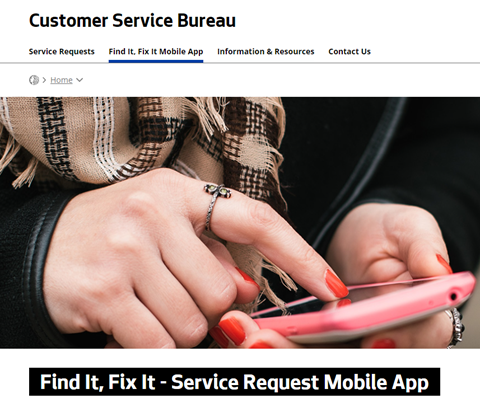
Your city government has made it a bit easier for residents to report an issue. New improvements launched in November 2022 to the City’s Find It, Fix It mobile app will make it easier to report an issue, track reports, and view your service requests on anything from a pothole to an abandoned vehicle.
City Council Meetings on the Internet
Viewing & Listening: You have a few options to view and hear Seattle City Council meetings. To view Council meetings live on Seattle Channel, CLICK HERE. You can also listen on your phone by calling 253-215-8782. To view the recordings of City Council meetings that have already occurred, CLICK HERE.
Our City Council meetings are held Tuesdays at 2:00 p.m. Even after returning to in-person meetings, the public will still be able to call in their comments at City Council meetings – this is an important upgrade for public input. I would have supported moving our main Council meeting to the evenings to make it easier for people with day jobs to visit us, but the technological upgrades now enable anyone to call into the public comment periods. Last year, we updated our City Council Rules and parliamentary procedures to improve the efficiency of the City Council by enabling Councilmembers to focus their work on city government business rather than on Resolutions on other issues such as international affairs.
Commenting: You can submit comments to me at Alex.Pedersen@seattle.gov or to all 9 Councilmembers at Council@seattle.gov. For the instructions on how to register and call in to a meeting, CLICK HERE. Sign up begins two hours prior to the meeting start time.
Meetings with Your Councilmember Pedersen: In Person Again!
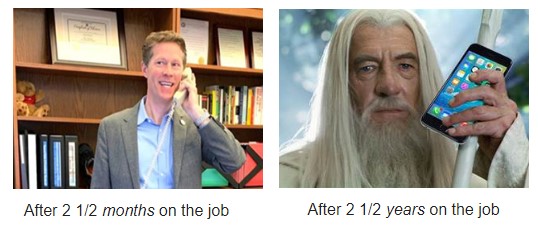
In-person office hours on most Friday afternoons are back to Magnuson Park’s Building 30 conference room at 6310 NE 74th Street, Seattle, WA 98115, just a couple of “blocks” into the park’s main entrance. You may continue to sign up through my website or by CLICKING HERE, so I can hear your ideas, concerns, and requests. You can also just send an e-mail to alex.pedersen@seattle.gov.
For previous e-newsletters, visit my blog by CLICKING HERE.
With gratitude,

Councilmember Alex Pedersen
Seattle City Council, District 4
Email: Alex.Pedersen@seattle.gov
Phone: (206) 684-8804
Posted: May 31st, 2023 under Councilmember Pedersen

